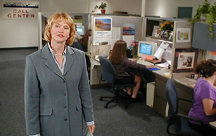
Pic. #1: Click for large image
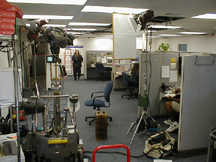
Pic. #2: Click for large image
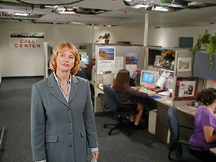
Pic. #3: Click for large image

Pic. #4: Click for large image
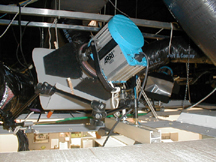
Pic. #5: Click for large image
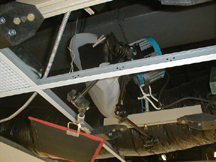
Pic. #6: Click for large image

Pic. #7: Click for large image
Regional Commercial Spot
We offer this sample production in order to demonstrate why the Porta-Grid Clamp is the best production tool you can have when shooting under drop ceilings. It clearly demonstrates that the Porta-Grid System can greatly enhance the overall production values of any project; not only, through improved lighting, but also by allowing for more creative freedom in camera movement. It reminds us that sometimes the littlest thing, like a light hanger, can make the biggest difference in a production.
But first, let's systematically go through the obstacles, the location presented, to achieving the Director's vision for this commercial spot. Though long in detail, this explanation is sure to reward you with a wealth of insight into how to achieve the best lighting you can when shooting under drop-ceilings.
The Challenge
The director's concept, for this spot for an auto glass replacement dealer, was that a company spokesperson would talk about the companies quick customer service, while walking through their computerized rapid response call in center. He wanted the spokesperson to begin their on camera presentation at the end of the row of cubicles seen in picture #1, and continue to walk and talk past the cubicles of phone operators, as the camera dollies back, to finish in the foreground as in picture. #1. A simple request, but a challenge to light.
The Obstacles
A close examination of pictures #1 and #2 reveal a number of obstacles presented by this location. First, given the length of the spokesperson's walk a number of key lights, feathered together for a consistent level, are necessary (in the end we used four). But, at a glance we can see that the final framing is so wide that there is virtually no place to put lights on stands from the camera right side that would not be in the shot. Likewise, there is virtually no place from which to light the background, and the operators in their cubicles, from the camera right side.
We could key the spokesperson, and light the operators, from the camera left side but that has it's own set of problems that are revealed in a close examination of picture #2. First and foremost, the aisle narrows toward the end of the row of cubicles in the deep background, making it impossible to key the spokesperson at the start her block (about where the women in blue is in picture #2) from a floor stand. Second, as you can see in picture #2 there is very little room to the left of the dolly track in which to set light stands. The lights would have to go very high, so as not to throw the shadow of the dolly onto the spokesperson.
Even if it were possible to set stands, keying from the camera left side is not an ideal key angle for two reasons. First, the light on spokesperson's face would be very flat and uninteresting to the camera side. In general a reverse key position, from the camera right side, looks better because the camera side of the face is modeled with a range of light and shadow. It is more interesting because there is a wider range of tonal values. Second, a camera left key position would throw the spokesperson's shadow onto the phone operators and their cubicles - a most undesirable effect.
Without a doubt, in a situation like this, the key should come from the camera right side, and as high as possible. That way we get better modeling on the spokesperson's face and her shadow is driven down and off camera to the left. Clearly, the ideal scenario would be to rig the keys from the ceiling on the camera right side. However, if we look at picture #3 (which is a slightly wider framing of our final shot) we see that the final frame is so wide, and with so little headroom, that there is no room below the ceiling to hang key lights, not to mention backlights - an all too common problem with traditional scissor clips w/ studs. Clearly, the lights will have to be rigged above the ceiling. However, a close examination of picture #4 reveals that it would be impossible to rig anything above the ceiling with conventional grip hardware - for the simple reason that there is nothing above the drop-ceiling on which to rig. As is quite often the case, the drop ceiling here covers office space that was carved out of a warehouse. The structural ceiling, as you can see in picture #4, is ten feet above the drop ceiling and out of reach - a seemingly insurmountable obstacle to our lighting design.
The Right Tool
Without a doubt, having the right tool - like a socket wrench to tighten a nut, or a hammer to drive a nail - can make a difficult task easier. Likewise, the Porta-Grid Clamp can make the impossible possible. For example, the clamp made it easy for us to overcome even the seemingly insurmountable obstacles that confronted us here. How? First, it is not dependent on rigging points above the ceiling to hang a light. Instead, it attaches directly to the drop ceiling so that you can rig a light anywhere on the ceiling. Second, unlike a scissor clip with stud, it can be over-slung on the ceiling grid (as shown in picture #5), so that neither the light nor the clamp hang below the ceiling and into the shot. In fact, the Porta-Grid worked so well under these circumstances that we ended up using sixteen of them to rig everything from above the ceiling - from multiple keys and back lights, to numerous motivated set lights. To be sure, this would not have been possible without the Porta-Grid Clamp.
This sample production clearly demonstrates that there is not a more effective way of enhancing the production values of lighting on locations with drop ceilings than the Porta-Grid System. For instance, the clamp enabled us to rig our key light from the camera right side, and achieve the better modeling of a reverse key position. It, likewise, enabled us to drive the shadow, created by the key, down and out of frame to the left so that it didn't fall on our background. The versatility of the clamp enabled us to rig not just one, but four separate key lights above the ceiling to cover the spokesperson's entire block. While, the extensive grip capability of the Porta-Grid System enabled us to feather the multiple keys together with nets, on Porta-Grid Articulating Arms (as shown in picture #6), so that the level was consistent.
Since the clamp makes it possible to rig lights above the ceiling, we were also able to rig multiple backlights to create separation between the spokesperson and the busy background. For the same reason, it also enabled us to rig numerous set lights above the ceiling to model the back walls with splashes of light as if from recessed ceiling cans. Finally, the Porta-Grid Clamp made it possible for us to use a motivated source lighting approach to the phone operators in the background. It was easy to replicate the direction of practicals on the set, because we could rig a light anywhere above the ceiling and out of the wide shot. To be sure, we would not have been able to accomplish such high production values without the Porta-Grid Clamp. Having the right tool made a world of difference in this situation.
Of course, we would not have been able to use the Porta-Grid Clamp so extensively, to such fine effect, if it were not for a third feature of the Porta-Grid Clamp - that it actually binds the drop ceiling grid together, enabling the ceiling to carry more weight. When ever you rig lights above the ceiling, no matter how you do it, you must remove the ceiling tile under the light and sometimes even the tile adjacent to it. If, as was the case here, the situation requires you to rig multiple keys, backlights, and even set lights from the ceiling, you may end up severely weakening the structural integrity of the ceiling by removing too many tiles. Without the tiles to space them, the grid parallels have a tendency to float and spread apart. The Porta-Grid clamp is designed to counter act this tendency.
Properly installed, the clamp spans the parallels of the drop-ceiling grid, and binds them together. Once securely attached by its' scissor clips, the clamp anchors the grid parallels and keeps them from floating apart. In the end, the drop ceiling grid can actually support more weight than it could with the tiles in place. As you can see by the concentration of Arri 1ks, 650s, and 300s in picture #7, the Porta-Grid System can greatly increase the load bearing capacity of a drop ceiling. In this case, we were able to further increase the capacity of the ceiling by rigging a Porta-Grid Safety Eye and Strain Relief Strap to a heating duct hanger in the vicinity of the lights. Designed to go up quickly, these Porta-Grid accessories transfer the load on the drop ceiling to the structural ceiling above.
As you can see here, the Porta-Grid Clamp and it's strain relief accessories can open up whole new possibilities for lighting from drop ceiling grids. You can now rig not only larger lights, but also more lights and grip hardware, than had ever been possible before. In the end, given the peculiar challenges presented by this particular location, the Porta-Grid System was, without a doubt, the right tool for the job. Without it, we would not have been able to achieve such high production values in the lighting.
The Porta-Grid System can not only enhance production values through improved lighting, but also by allowing for more creative freedom in camera movement. Clearly, had we not be able to rig our lights and gobos above the ceiling in this sample production, we would not have been able to dolly with the spokesperson without catching a stand in the shot. By bringing sophistication and control to lighting from the ceiling, the Porta-Grid System eliminates the usual forest of C-stands on the floor. Which, in this case, allowed us to track with the spokesperson throughout the shot. As you can clearly see in this sample production, light placement is not compromised by camera movement; and, camera movement is not compromised by light placement. To be certain, the Porta-Grid System greatly enhanced the overall production values of this spot by allowing the creative freedom to move the camera. It reminds us that sometimes the littlest thing, like a light hanger, can make the biggest difference in a production.
This production demonstrates just a few of the many exclusive features of the Porta-Grid System that enable it to turn any ordinary drop-ceiling into a full blown studio grid. To be certain, the same features that made the Porta-Grid System so effective under these circumstances, also make it effective under any circumstances. By virtue of the fact that it worked here, when nothing else would, proves that it is sure to work anywhere, anytime, under any circumstances - site unseen. How many other grip lines can make that guarantee? Without a doubt, the Porta-Grid System is the best production tool you can have in your bag of tricks when shooting under drop ceilings.
The Porta-Grid System is registered w/ U.S.Patent & TM Office.

